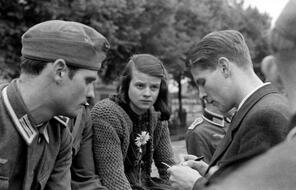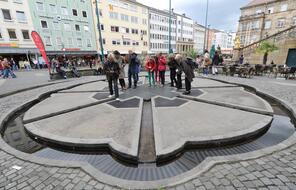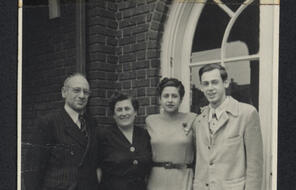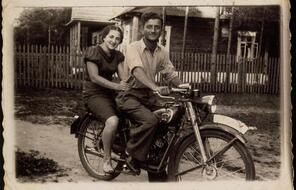Finding a Voice in Art
Subject
- History
- Social Studies
Language
English — USUpdated
The Arpilleras of Chile (with Marjorie Agosin)
On September 11, 1973, a group of Chilean military officers led by General Augusto Pinochet struck down Salvador Allende’s democratically elected government. Seventeen years of oppressive dictatorship followed in Chile.
The Pinochet dictatorship routinely violated human rights. Among other abuses, thousands of Chileans were detained, tortured, killed, or "disappeared"—forcibly abducted or taken for questioning, never to return. More than 3,000 people vanished. Thousands more were rounded up and held as political prisoners or executed at the National Stadium, a large sports complex in the city of Santiago. Pinochet's government targeted these Chileans in an effort to suppress political opposition and dissent.
In response, a grassroots movement emerged among Chilean women. The majority of people taken in for questioning or removed from their communities were men, and immediately many women who loved them began searching for them—a dangerous, even revolutionary act. Through these searches, the women began to join together, creating a community and sharing resources.
Women and the Disappeared
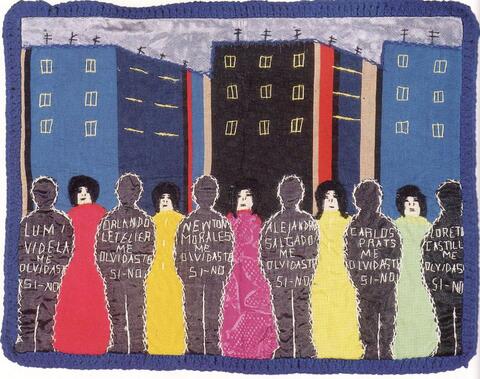
Women and the Disappeared
This arpillera was created by Violeta Morales. The faceless figures next to the women represent the missing victims who dared to oppose Pinochet’s dictatorship in Chile, from 1973 to 1990.
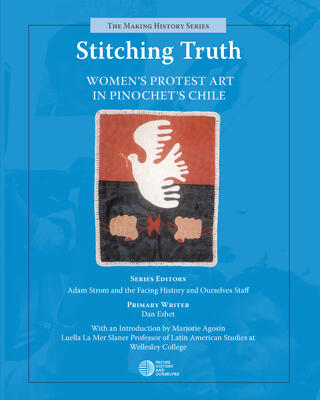
Get the Book
Deepen your study of the women's protest movement in Chile during Pinochet's dictatorship with our resource Stitching Truth.
The Roman Catholic Church, under the leadership of Cardinal Raúl Silva Henríquez, formed community centers to support families of the disappeared. The women who came to these centers participated in workshops, taught one another practical skills, and began to make handicrafts. Turning to the folk art of embroidery, they found a way to use the workshops for more than just a source of income and support; these became places to gather and heal and talk about their loved ones who had been disappeared, and they also became places for the women to find their voices. In brilliant tapestries, called arpilleras, the women began to stitch together the stories of the disappeared and of other victims of the military dictatorship.
Violeta Morales was one of the women who began creating arpilleras after her brother, Newton, was taken by Pinochet’s secret police, commonly called the DINA. After some members of a political group (known as MIR) took up arms against the new dictatorship, the DINA hunted down anyone associated with the group, whether they participated in the armed resistance or not. Newton did not participate in the resistance, but he was a member of MIR. Violeta Morales writes,
When Newton came home [on August 13, 1974,] the men took him by the arms and he called out to my mother who was in the kitchen. “Mother, the DINA is taking me away.” My mother didn’t understand what was happening at the time because she had never been political. The men tried to assure her because she was grasping my brother. One of the agents took her aside and said, “Don’t worry ma’am; we’ll bring him back in ten minutes—we only want to speak with him. We’re friends from work.” My brother looked pale and didn’t say anything, probably so as not to frighten our mother. . . . When they took my brother Newton away from home, my other brother was arriving and followed the wagon in his taxi. From a distance he saw them bring Newton close to the church of San Francisco . . .
After our brother’s disappearance, we began looking for him everywhere—like all the relatives of the detained. The DINA, Directorate of National Intelligence, was created in July 1974, and the military continued refining its methods and applying them more cruelly. We began doing things immediately and found out that at the Pro-Paz Committee, which was located on Santa Monica Street, they were getting all types of reports about abuses and violations of human rights. We began looking for our brother in jails, cemeteries, morgues, commissaries, and anywhere a military regiment existed. We also went to the law courts, and at many of the places we went, they received us with machine guns just for asking questions and for going around searching for the detained-disappeared. We sent thousands of letters abroad asking for help as well. We even went so far as sending letters to the leaders of the dictatorship themselves, but nothing came of all this. . . .
From the despair emerged the idea of making arpilleras. . . . We didn’t want to make something that would function as a decoration. We wanted to design a handmade product that would denounce what we and our country were living. We wanted to tell people about our personal experiences through pieces of our own clothing. We wanted to embroider our story, the harsh and sad story of our ruined country. At first, we had problems getting the materials, especially the cloth and the wool. So, we got the idea of cutting up our own clothes and unraveling our sweaters to make the first arpilleras.
We opened our workshop in 1974, but we didn’t go public until 1975. In those years, I took full responsibility for the search of my brother. My sister had been kidnapped by a cab driver who interrogated her about the names of people she knew. She told him about her years as a volunteer worker in rural organizations and about all her activities as a university student [and then she was released]. After that, my sister was afraid to go out into the street to look for our brother. I was scared too. We were all afraid to keep on asking and searching. Then I put all my energy into the arpillera workshop; it was sometimes the only thing that kept me balanced emotionally. There I found other people who were suffering from the same thing and trying to help them sometimes helped me with my own tragedy. . . .
In the same arpillera workshops, we started training sessions to teach the women about solidarity and their role in the soup kitchens and other group activities. Sometimes it was hard teaching the women in the townships because they treated us worse than lepers; they believed that our protest activities would put them in jail or among the disappeared. It was hard convincing them that if we didn’t unite and support each other, then we wouldn’t be able to do anything. Many times the money that we got from the sale of arpilleras paid some child’s medical fees or gave relief to a workshop family member. . . .
We women of Chile who were involved in the struggle had a more difficult time because, as we now realize, our men were so machista [male chauvinist]. Instead of helping us in those years, they pulled us down. Some of the women’s husbands would not let them attend meetings or help in the training or with the solidarity work. In those years, men never said, “Compañera, let’s go out and struggle together to change the reality of this country.” Women were the ones who fought. . . .
As a woman, I realized as part of this process of fighting for liberty in my country that the myth that they had driven into our heads all our lives—that the man is the one with the power and physical force to control everything—only goes so far. It’s relative, and it’s like all the other myths that they implanted in us women. It was the women comrades who managed to end the military nightmare in our country; they had the strength that the men lacked or lost along the way. Women, who were always housewives, woke up and didn’t submit until freedom returned to their country and its citizens. . . . 1
Marjorie Agosín, a poet and human rights activist from Chile, recalls how the community created by the arpilleristas was both a healing space and a means of advocating for justice.
The women who started this arpillera movement began their journey in the places of fear—hospitals, morgues, and cemeteries. They told me how they would recognize one of their own: each carried a mark of pain. They would ask each other whether they were there for a vanished son or a husband and how many children had been taken, when they had disappeared. Violeta Morales, one of the founders of the movement, always said that she was able to recognize her own grief in the faces of others. And they recognized the shoes worn out from walking the streets in search of their loved ones. Their first conversations were heavy with the language of pain, but the exchanges quickly turned into a language of solidarity. Slowly, they began to think of ways of uniting in a collective project that would transcend their individual plights. Soon they gained the support of the Vicariate of Solidarity, a branch of the Catholic Church. This organization, under the direction of Cardinal Silva Henríquez, a noted human rights activist, was created to protect the country’s victims.
. . . On many occasions, I visited the workshops where the arpilleristas gathered. As they stitched, they spoke. Sometimes they needed to stop their sewing because the cloth was wet with their tears. But mutual support and love allowed them to continue embroidering the stories of their children, those they had lost, and their country. The art of the arpillera combines the individual pain of each of these women with the collective pain of all Chileans. 2
As the number of workshops grew, and the arpilleristas gained confidence in their voices, they decided to stage public protests. Agreeing to use only peaceful methods, including dancing alone in public squares and chaining themselves to public buildings, mothers, daughters, and sisters of the disappeared took to the streets. They marched around central plazas, and when the police dispersed them, they staged hunger strikes, some lasting weeks. The strikes led to more concern about the disappeared, both within Chile and internationally.
In addition, with the help of the Roman Catholic Church, the arpilleras themselves found an international audience; the tapestries were smuggled out of Chile and bore witness around the world to the tragedy of the dead and the missing. Agosín writes,
The arpilleras were created as a response to censorship, as a way to fight against the impunity enjoyed by government forces. They became an important vehicle for spreading the news about Chile’s situation. These pieces of cloth traveled abroad: customs officials never suspected that these humble wall hangings had the power to transform those who touched them. The arpilleras made it to museums around the world, to the calendars of Amnesty International, to the homes of exiles, and to many others who cared deeply about Chile. 3
Amid growing domestic and international pressure, General Pinochet stepped down in 1990. Though his departure from government was not a direct result of the arpilleristas’ work, historian Peter Winn believes that the arpilleras were particularly successful “in making Pinochet the emblematic dictator and human rights abuser of the era” and “in creating international sympathy and support for his victims and opponents.” 4
A generation of artists in Chile continues to follow in the footsteps of these activists, using arpilleras to provoke discussions about how to incorporate the memory of the missing into Chile’s history. These artists use art as a way to showcase the power of women and the effectiveness of nonviolent protest.
In 2006, Michelle Bachelet was elected as the first female president of Chile. Her father served in Allende’s government and was imprisoned and tortured by Pinochet’s secret police; he died of a heart attack in prison. Both Bachelet and her mother were also detained and tortured by the Pinochet regime and then sent into exile. To many people, Bachelet symbolizes the radical transformation of Chile since the dictatorship. She led the country as president from 2006 to 2010, and after three years of serving in the United Nations, she was reelected as president of Chile in 2013.
Connection Questions
- Why did the women whose family members disappeared in Chile choose to make tapestries? What were their practical and political reasons? What other ways are there to express dissent in repressive times?
- The arpilleristas used the art of embroidery to document both their personal and their political stories. What is unique about the power of visual art to tell stories?
- Look carefully at the arpillera in this reading. What story does the arpillera tell? (Think about the colors the artist chose, the images she selected, and the arrangement of the objects in the arpillera.)
- Creating arpilleras made use of a set of traditionally female domestic skills—sewing, weaving, and embroidering, for example. In what ways were the arpilleristas able to turn their disadvantages as women in a traditional society into a political tool?
- As the arpilleras received international attention, they also influenced women in similar grassroots movements. In Peru, Argentina, and South Africa, for example, women who learned about the arpilleristas also formed social justice movements that used sewing as a technique to protest human rights abuses. Why do you think the strategy of the arpilleristas was so transferable? Attractive? Influential?
- Some believe that artists should focus on beauty and avoid politics. Do you agree or disagree? How can art promote human rights? What function can art have in political struggles? In education?
- 1In Marjorie Agosín, Tapestries of Hope, Threads of Love: The Arpillera Movement in Chile (Rowman & Littlefield, 2008), 83–91. Reproduced by permission from Rowman & Littlefield Publishing Group.
- 2Marjorie Agosín, “Introduction,” in Stitching Truth: Women's Protest Art in Pinochet's Chile (Brookline, MA: Facing History and Ourselves, 2009), ix–xii. Reproduced by permission from Rowman & Littlefield Publishing Group.
- 3Marjorie Agosín, “Introduction,” in Stitching Truth: Women's Protest Art in Pinochet's Chile (Brookline, MA: Facing History and Ourselves, 2009), x. Reproduced by permission from Rowman & Littlefield Publishing Group.
- 4Peter Winn, email message to Facing History, February 6, 2006.
How to Cite This Reading
Facing History & Ourselves, “Finding a Voice in Art”, last updated August 2, 2016.


